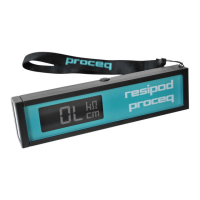Global reference values at 20°C for the electrical resistivity of concrete of mature
structures (age > 10 years).
Environment Concrete resistivity ρ kΩcm
Ordinary Portland Cement
(CEM I)
Blast furnace slag cement
(>65% slag) or fly ash (>25%)
or silica fume (5%)
Very wet, submerged, splash
zone, fog room
5-20 30-100
Outside, exposed 10-40 50-200
Outside, sheltered, coated,
hydrophobised (not carbon-
ated) (20°C / 80% RH)
20-50 100-400
Outside sheltered as above
(Carbonated)
100 and higher 200-600 and higher
Indoor climate (carbonated)
20°C / 50%RH
300 and higher 400-1000 and higher
Resistivity mapping
Mapping out the resistivity of a structure enables useful interpretations to be made by comparing
the values against those in the above table. Please note that the temperature correction described
earlier should be taken into consideration. If exposure conditions are the same, varying resistivity
values may indicate local variations of the water/cement ratio. If it is known that the concrete is
homogenous throughout the structure, then the resistivity measurements can be used to determine
how relatively wet and dry the various areas are.
Correlation to permeability
Studies have shown that resistivity can be directly correlated to chloride diffusion rate. On site
mapping of the resistivity of a concrete structure will identify the most permeable areas. Such
areas are more likely to be susceptible to chloride penetration. The Resipod model with 38 mm
spacing conforms to the AASHTO T 358 Surface Resistivity Test Method which uses surface
resistivity as an indication of the permeability of concrete. Details of the test can be found on the
official AASHTO website http://tig.transportation.org/Pages/SurfaceResistivityTest.aspx.
On site assessment of curing efficiency
Resistivity measurements may be used on site to determine premature drying of concrete. This
is a particularly important application in hot countries where premature drying out can lead to
structural weakening due to non-completion of the hydration reaction. The method uses the strong
dependence of resistivity on the humidity of the concrete. Site measurements are compared with
measurements made on a saturated reference cylinder to define a relative resistivity which can be
used to isolate the effects of humidity and thereby determine premature drying. Please refer to
“Electrical resistivity as a tool to on site assessment of curing efficiency – by L. Fernandez Luco,
C. Andrade and M.A. Climent (June 2009)”.
Resistivity measurements and cathodic protection systems
The effectiveness of a cathodic protection system depends very much on the resistivity of the
concrete. Mapping out the resistivity prior to installation allows the structure to be divided into
separate zones requiring different levels of current flow.

